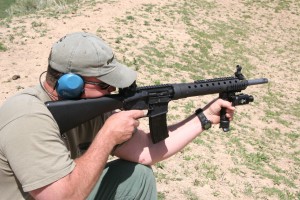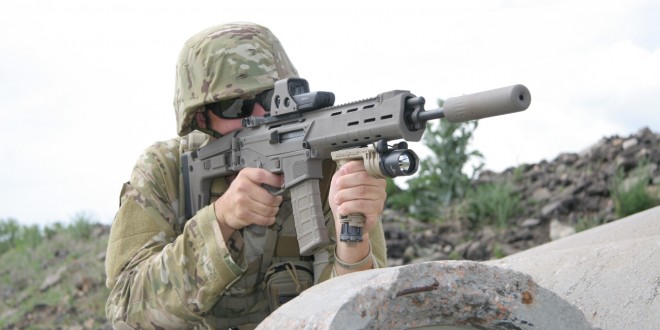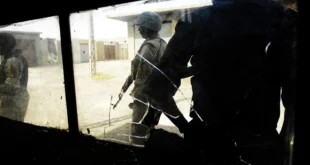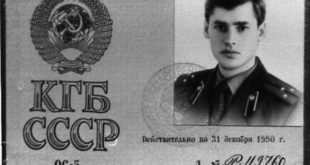The benefits of training to shoot while moving.
by Gary Paul Johnston
Traditionally, cops have been trained to shoot while standing still. By now it should be pretty clear where this is going, and going should be the name of the game when the going gets tough.
When I became a police officer, all cops, military personnel and competitors shot from positions. These shooters moved to and from positions, but rarely while carrying a loaded firearm in their hands, and virtually never while shooting. Thus, because people’s actions are a result of their training, all of these shooters continued the practice of emptying their guns virtually all of the time while remaining where they had planted their feet. As a result, too many in uniform died where they stood.
READ MORE from Soldier of Fortune on Shoot and Scoot in a war zone
As with the vast majority of law enforcement training, both then and now, time and budgetary constraints dictate just what kind of training is provided. Any variance in the established program is usually scoffed at unless someone in administration thinks of it, but few in administration shoot their sidearms. If an agency conducts firearms qualification more than once or twice each year, it’s ahead of the pack, but maybe not by much. This is true even if such training is realistic, whatever that means, but it rarely is. Instead, the program usually follows state or federal guidelines, probably drawn up by some firearms instructor decades ago. Going outside of these parameters is often seen as “rocking the boat.”
The truth is, armed assailants usually move while they are shooting, and often in an unpredictable manner. Those at whom they are shooting (you) might also move in the same way. This is because of the tremendous level of stress that instantly occurs when the balloon goes up, especially if it is unanticipated. Since there is no training as to movement during a gunfight, those who do move tend to do it instinctively. However, things are changing and not for the better.
When you see a news clip of a terrorist training camp with shooters practicing military assault maneuvers, what do you think about? How about when you see similar training being carried out here in the U.S. by some anti-government or hate group? What about those in prisons (most of whom will be released before you retire) who practice attacking (to kill) police officers? Is that manager’s position at the local fast food restaurant looking better, or would you rather get serious about training?
In my opinion all firearms training should involve movement. Even when shooting from positions of cover, if you emerge, fire, and then duck behind cover again, you should emerge from a different location or level the next time, as your assailant will probably be waiting for you. Failing to execute this basic tactical maneuver continues to get U.S. military personnel killed in the Global War On Terrorism.
If someone is advancing or retreating while shooting, such as in a crisis scenario, he or she should practice a zig-zag and angled movement in addition to a straight line, as lateral movement is the key to throwing your assailant off target. Force-on-force training will demonstrate this, and it doesn’t have to be expensive.
Toy Guns
Force-on-force training can involve as little as using “blue guns” (non-guns) to stalk each other in a store room or other scenario. Whatever skills I attained as a police officer I must credit partially to playing “guns” as a kid with friends almost every weekend. This usually involved play guns or even real guns I collected that were broken or missing parts. I’ve also wondered what the neighbors must have thought, but some of their kids participated and things were a lot different in Los Angeles in the 1950s.
Whatever the case, we established rules of what could be shot through and what was bullet proof (concealment vs. cover) and so forth. We hid in bushes, climbed trees and changed our positions, always trying to get the advantage. It was hide and seek with “bang-bang, you’re dead” instead of “tag, you’re it.”
My agency began force-on-force training in the late 1970s with cotton balls. This involved dedicated revolvers that would accept only .38 Special casings loaded with moist cotton balls and a primer. Now, instead of “you’re it,” it was you’re hit. Strict safety and control was the order of the day, including eye protection, as the cotton balls stung when they hit.
Paint-ball training is more expensive and it’s also dirtier with misses leaving stains on walls, gear and clothing, but it’s excellent force-on-force training. Finally, there is the use of special issue pistols using proprietary paint-ball type projectiles. However, these projectiles can draw blood and use of them requires total face protection. This training is also expensive, but it is arguably the best reality-based training in preparation for the real thing.
Side-stepping should be mandatory training with big-step left and right movements perfected. A good drill is to have a shooter engage at least a half-dozen targets, starting at one end by shooting at least one round in each, side-stepping to the next target, and then repeating in the other direction to the starting point, reloading as necessary. The student and instructor can then walk down the line scoring, taping and talking with little down time.
If only one target is involved, the drill can be similar by shooting and moving back and forth, or moving first to clear non-combatant targets placed behind the threat. Use your imagination to replicate reality. The shooter can also practice dropping to his or her knees to be able to clear bystander targets. For practice, knee pads (“San Francisco slippers”) and elbow pads should be mandatory.
Shooting Behind You
Turning to shoot should not involve crossing your legs, stepping to the rear or merely spinning around in almost the same place. It should include ducking while taking a giant, hopping step to one side, while taking a wide turn on one foot to face the threat some five feet or so from where you started. This gets you out of your assailant’s line of sight, causing him to have to re-think and adapt. If you can’t do this because of some disability, then do the best you can, but try to get out of the line of fire. If cover or concealment is available, use it! Does all this take more training time? You bet!
Bounding Bullets
What about shooting at an assailant who is peering from around a corner? Must you take pin-point aim to hit him? Probably not. Depending on your position and how much of the suspect is visible, you can probably hold your weapon close to the wall and fire into the wall about mid-way and ricochet your bullet right alongside the wall to make a hit. This works especially well with the shotgun. The material of the wall and its smoothness will affect how well this can be done. Hard surfaces work best. Although it may drive administration crazy, you can practice this using the concrete walls of your indoor range.
How about an assailant shooting from behind a vehicle? By shooting at the ground on your side of the car in line of where his feet would be, you can hit his ankles. Again, this is especially effective with buckshot. Tow a junk car to your range to practice this.
Lumen Aid
Lights can give you an advantage even in broad daylight, as they serve as a distraction. Weapon-mounted lights with a strong-hand pressure switch are best, such as are offered by SureFire. They allow one-hand operation and transitioning, but a hand-held tactical light of at least 60 lumens can also do the job. Lights are especially useful in low light, but a good light can momentarily blind your assailant even at high noon. I prefer a light with at least 100 lumens.
Blinding light can also hide your movement and two officers can use blinding light to apprehend a combative subject. One officer can blind the person while the other advances unseen. One of the best light-fighting courses available is offered by BlackHawk Products Group (800-694-5263, blackhawk.com) and your people will take to it like a duck to water.
By all means, continue your agency’s required qualification course, but go beyond it for all other firearms training. If you run into problems with administration, put it on paper and mention vicarious liability. That always gets attention, as it should, and it isn’t a lie. The bad stuff also rolls uphill and administration knows it. The lives you save could not only be those of your people, but also of those you protect. Get after it.
 Soldier of Fortune Magazine The Journal of Professional Adventurers
Soldier of Fortune Magazine The Journal of Professional Adventurers






